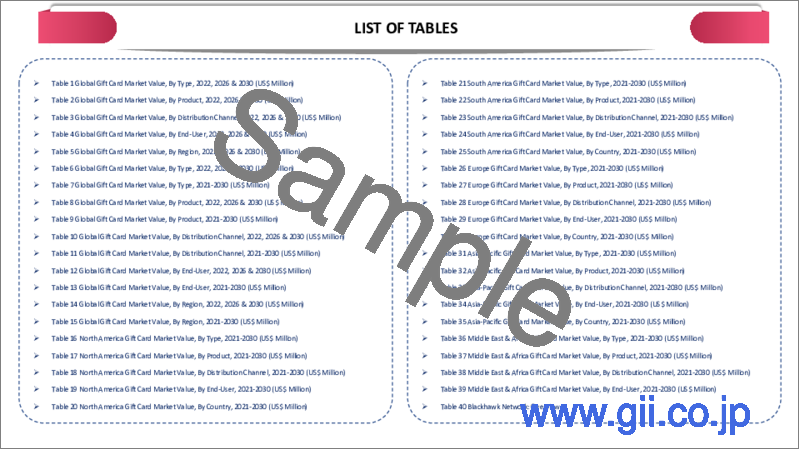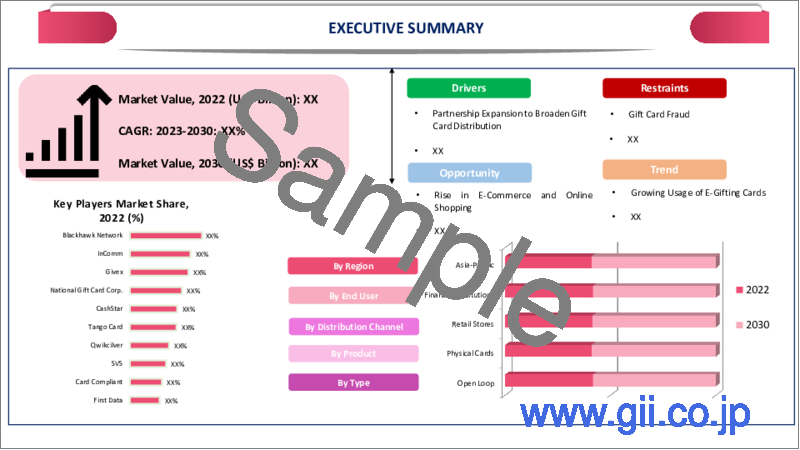|
|
市場調査レポート
商品コード
1255842
ギフトカードの世界市場-2023-2030Global Gift Card Market - 2023-2030 |
||||||
|
● お客様のご希望に応じて、既存データの加工や未掲載情報(例:国別セグメント)の追加などの対応が可能です。 詳細はお問い合わせください。 |
|||||||
| ギフトカードの世界市場-2023-2030 |
|
出版日: 2023年04月11日
発行: DataM Intelligence
ページ情報: 英文 212 Pages
納期: 約2営業日
|
- 全表示
- 概要
- 目次
市場概要
世界のギフトカード市場は、有利な成長を遂げると予測されています。同市場は、予測期間中(2023-2030年)に13.8%のCAGRで成長しています。
ギフトカードは、誕生日や祝日、特別なイベントなど、さまざまなシーンで便利で柔軟なギフトの選択肢を提供するため、近年ますます人気が高まっています。また、企業のギフトやインセンティブとしても人気があります。ギフトカードは、贈る側と贈られる側の双方に利便性を提供します。オンラインでも店頭でも購入でき、多くの小売店ではEメールやテキストメッセージで送信できる電子ギフトカードも提供しています。これにより、いつでもどこでも簡単にギフトカードを購入し、贈ることができるようになりました。
市場力学
ギフトカードの利便性と柔軟性
小売業者にとって、ギフトカードは販売や在庫管理の面で柔軟性があります。ギフトカードは、小売業者にとって、特定の商品を仕入れたり、在庫を管理したりする必要がなく、事前に売上を上げることができる方法となります。これにより、小売業者はキャッシュフローをより適切に管理し、在庫過多や在庫不足のリスクを軽減することができます。
ギフトカードの利便性と柔軟性を高めているもう一つの要因は、オンラインで購入できることです。近年、消費者がオンラインショッピングを好むようになったため、オンラインギフトカードの売上は大きく伸びています。これにより、消費者は昼夜を問わず、自宅に居ながらにしてギフトカードを購入することができるようになりました。さらに、ギフトカードの利便性と柔軟性は、ギフトカードをパーソナライズする機能によってさらに向上しています。多くのギフトカードプロバイダーは、ギフトカードに個人的なメッセージや写真を追加する機能を提供するようになり、より一層心のこもったパーソナルな贈り物となりました。
ギフトカード詐欺
ギフトカード詐欺は、不正なオンライン取引を利用することで発生します。犯罪者は盗んだクレジットカード情報を使ってオンラインでギフトカードを購入したり、ボットを使ってギフトカード番号やPINを生成したりすることができます。その結果、小売業者はチャージバックや収入減に見舞われ、評判や消費者の信頼が損なわれることになります。また、ギフトカード詐欺は消費者に直接影響を与えることもあります。消費者が購入したギフトカードが後で不正であることが判明した場合、換金や返金を受けることができない可能性があります。その結果、不満が募り、ギフトカード市場に対する信頼が損なわれる可能性があります。
COVID-19の影響分析
COVID-19分析では、COVID前シナリオ、COVIDシナリオ、COVID後シナリオに加え、価格力学(パンデミック時やCOVID前シナリオとの比較による価格変動を含む)、需要-供給スペクトラム(取引制限や封鎖、その後の問題による需要と供給のシフト)、政府の取り組み(政府機関による市場、セクター、産業の活性化に関する取り組み)、メーカーの戦略的取り組み(COVID問題を軽減するためのメーカーの取り組み)についても解説しています。
目次
第1章 調査手法と範囲
- 調査手法
- 調査目的および調査範囲について
第2章 定義と概要
第3章 エグゼクティブサマリー
- タイプ別スニペット
- 製品別スニペット
- 流通チャネル別スニペット
- エンドユーザー別スニペット
- 地域別スニペット
第4章 市場力学
- 影響要因
- 促進要因
- ギフトカードの利便性と柔軟性
- 抑制要因
- ギフトカード詐欺
- 機会
- 影響分析
- 促進要因
第5章 産業分析
- ポーターのファイブフォース分析
- サプライチェーン分析
- 価格分析
- 規制分析
第6章 COVID-19の分析
- COVID-19の解析について
- COVID-19シナリオ前
- 現在のCOVID-19シナリオ
- ポストCOVID-19または将来のシナリオ
- COVID-19 の中での価格変動
- 需給スペクトル
- パンデミック時の市場に関連する政府の取り組み
- メーカーの戦略的な取り組み
- 結論
第7章 タイプ別
- オープンループ
- クローズドループ
第8章 製品別
- 電子ギフトカード
- 物理カード
第9章 流通チャネル別
- 小売店
- オンラインプラットフォーム
- その他
第10章 エンドユーザー別
- 小売
- 飲食店
- エンターテイメント
- 旅行
- その他
第11章 地域別
- 北米
- 米国
- カナダ
- メキシコ
- 欧州
- ドイツ
- 英国
- フランス
- イタリア
- ロシア
- その他欧州
- 南米
- ブラジル
- アルゼンチン
- その他南米地域
- アジア太平洋地域
- 中国
- インド
- 日本
- オーストラリア
- その他のアジア太平洋地域
- 中東・アフリカ地域
第12章 競合情勢
- 競合シナリオ
- 市況分析・シェア分析
- M&A分析
第13章 企業プロファイル
- Blackhawk Network
- 会社概要
- 製品ポートフォリオと説明
- 財務概要
- 主な展開
- InComm
- Givex
- National Gift Card Corp.
- CashStar
- Tango Card
- Qwikcilver
- SVS
- Card Compliant
- First Data
第14章 付録
- 私たちとサービスについて
- お問い合わせ
Market Overview
The global gift card market reached US$ XX million in 2022 and is projected to witness lucrative growth by reaching up to US$ XX million by 2030. The market is growing at a CAGR of 13.8% during the forecast period (2023-2030).
Gift cards have become increasingly popular in recent years, as they offer a convenient and flexible gift-giving option for many occasions, including birthdays, holidays and special events. They are also a popular option for corporate gifts and incentives. Gift cards also offer convenience for both the gift-giver and the recipient. They can be purchased online or in-store and many retailers offer electronic gift cards that can be sent via email or text message. This makes it easy to purchase and send gift cards from anywhere, at any time.
Market Dynamics
Convenience and flexibility in gift cards
For retailers, gift cards offer flexibility in terms of sales and inventory management. Gift cards provide a way for retailers to generate sales in advance, without needing to stock specific products or manage inventory. This can help retailers to better manage their cash flow and reduce the risk of overstocking or understocking.
Another factor that contributes to the convenience and flexibility of gift cards is the ability to purchase them online. Online gift card sales have grown significantly in recent years, as consumers increasingly prefer to shop online. This allows consumers to purchase gift cards from the comfort of their own homes, at any time of day or night. Furthermore, the convenience and flexibility of gift cards is further enhanced by the ability to personalize them. Many gift card providers now offer the ability to add a personal message or photo to the gift card, making it an even more thoughtful and personalized gift.
Gift card fraud
The gift card fraud can occur is through the use of fraudulent online transactions. Criminals can use stolen credit card information to purchase gift cards online or they can use bots to generate gift card numbers and PINs. This can result in chargebacks and lost revenue for retailers, as well as damage to their reputation and consumer trust. Gift card fraud can also impact consumers directly. If a consumer purchases a gift card that is later found to be fraudulent, they may be unable to redeem it or receive a refund. This can result in frustration and dissatisfaction and can damage their trust in the gift card market.
COVID-19 Impact Analysis
The COVID-19 Analysis includes Pre-COVID Scenario, COVID Scenario and Post-COVID Scenario along with Pricing Dynamics (Including pricing change during and post-pandemic comparing it with pre-COVID scenarios), Demand-Supply Spectrum (Shift in demand and supply owing to trading restrictions, lockdown and subsequent issues), Government Initiatives (Initiatives to revive market, sector or Industry by Government Bodies) and Manufacturers Strategic Initiatives (What manufacturers did to mitigate the COVID issues will be covered here).
Segment Analysis
The global application container market is segmented based on type, product, distribution channel, end-user and region.
The growing customizable design and greater control over the purchasing experience drives the segment growth
Closed loop gift cards offer retailers greater control over the purchasing experience. Because these gift cards can only be used at a specific retailer or brand, the retailer can ensure that the customer has a positive experience. This can include ensuring that the card is properly activated, that the correct balance is loaded onto the card and that the customer is able to find the products they want. By providing a positive purchasing experience, retailers can encourage repeat business and increase customer loyalty. Closed loop gift cards offer retailers the ability to customize the design and branding of the gift card. This can help to reinforce the retailer's brand identity and create a more engaging and memorable experience for customers. By customizing the design of the gift card, retailers can increase the perceived value of the gift card and encourage customers to purchase them as gifts.
Geographical Analysis
The growing E-commerce in the region strengthen the growth of the Asia-Pacific gift card market
E-commerce has opened up a world of shopping possibilities for consumers, as they can now purchase goods and services from retailers all over the world. This has created a demand for gift cards that can be used at a wide variety of retailers, as consumers want the flexibility to shop wherever they choose. In response, many retailers have started offering gift cards that can be used both online and in-store, increasing their appeal to consumers. The rise of e-commerce has led to a greater emphasis on security and fraud prevention. Digital gift cards are often more secure than traditional gift cards, as they can be tracked and monitored to prevent fraud. This has helped to increase consumer confidence in the use of gift cards, which has in turn contributed to the growth of the Asia-Pacific gift card market.
Competitive Landscape
The major global players include: Blackhawk Network, InComm, Givex, National Gift Card Corp., CashStar, Tango Card, Qwikcilver, SVS, Card Compliant and First Data.
Why Purchase the Report?
- To visualize the global application container market segmentation based on type, product, distribution channel, end-user and region, as well as understand key commercial assets and players.
- Identify commercial opportunities by analyzing trends and co-development.
- Excel data sheet with numerous data points of application container market-level with all segments.
- PDF report consists of a comprehensive analysis after exhaustive qualitative interviews and an in-depth study.
- Product mapping available as excel consisting of key products of all the major players.
The global gift card market report would provide approximately 69 tables, 67 figures and 212 Pages.
Target Audience 2023
- Manufacturers/ Buyers
- Industry Investors/Investment Bankers
- Research Professionals
- Emerging Companies
Table of Contents
1. Methodology and Scope
- 1.1. Research Methodology
- 1.2. Research Objective and Scope of the Report
2. Definition and Overview
3. Executive Summary
- 3.1. Snippet by Type
- 3.2. Snippet by Product
- 3.3. Snippet by Distribution Channel
- 3.4. Snippet by End-User
- 3.5. Snippet by Region
4. Dynamics
- 4.1. Impacting Factors
- 4.1.1. Drivers
- 4.1.1.1. Convenience and flexibility in gift cards
- 4.1.1.2. XX
- 4.1.2. Restraints
- 4.1.2.1. Gift card fraud
- 4.1.2.2. XX
- 4.1.3. Opportunity
- 4.1.3.1. XX
- 4.1.4. Impact Analysis
- 4.1.1. Drivers
5. Industry Analysis
- 5.1. Porter's Five Forces Analysis
- 5.2. Supply Chain Analysis
- 5.3. Pricing Analysis
- 5.4. Regulatory Analysis
6. COVID-19 Analysis
- 6.1. Analysis of COVID-19
- 6.1.1. Before COVID-19 Scenario
- 6.1.2. Present COVID-19 Scenario
- 6.1.3. Post COVID-19 or Future Scenario
- 6.2. Pricing Dynamics Amid COVID-19
- 6.3. Demand-Supply Spectrum
- 6.4. Government Initiatives Related to the Market During Pandemic
- 6.5. Manufacturers Strategic Initiatives
- 6.6. Conclusion
7. By Type
- 7.1. Introduction
- 7.1.1. Market Size Analysis and Y-o-Y Growth Analysis (%), By Type
- 7.1.2. Market Attractiveness Index, By Type
- 7.2. Open Loop*
- 7.2.1. Introduction
- 7.2.2. Market Size Analysis and Y-o-Y Growth Analysis (%)
- 7.3. Closed Loop
8. By Product
- 8.1. Introduction
- 8.1.1. Market Size Analysis and Y-o-Y Growth Analysis (%), By Product
- 8.1.2. Market Attractiveness Index, By Product
- 8.2. E-Gift Cards*
- 8.2.1. Introduction
- 8.2.2. Market Size Analysis and Y-o-Y Growth Analysis (%)
- 8.3. Physical Cards
9. By Distribution Channel
- 9.1. Introduction
- 9.1.1. Market Size Analysis and Y-o-Y Growth Analysis (%), By Distribution Channel
- 9.1.2. Market Attractiveness Index, By Distribution Channel
- 9.2. Retail Stores*
- 9.2.1. Introduction
- 9.2.2. Market Size Analysis and Y-o-Y Growth Analysis (%)
- 9.3. Online Platforms
- 9.4. Others
10. By End-User
- 10.1. Introduction
- 10.1.1. Market Size Analysis and Y-o-Y Growth Analysis (%), By End-User
- 10.1.2. Market Attractiveness Index, By End-User
- 10.2. Retail*
- 10.2.1. Introduction
- 10.2.2. Market Size Analysis and Y-o-Y Growth Analysis (%)
- 10.3. Restaurants
- 10.4. Entertainment
- 10.5. Travel
- 10.6. Others
11. By Region
- 11.1. Introduction
- 11.1.1. Market Size Analysis and Y-o-Y Growth Analysis (%), By Region
- 11.1.2. Market Attractiveness Index, By Region
- 11.2. North America
- 11.2.1. Introduction
- 11.2.2. Key Region-Specific Dynamics
- 11.2.3. Market Size Analysis and Y-o-Y Growth Analysis (%), By Type
- 11.2.4. Market Size Analysis and Y-o-Y Growth Analysis (%), By Product
- 11.2.5. Market Size Analysis and Y-o-Y Growth Analysis (%), By Distribution Channel
- 11.2.6. Market Size Analysis and Y-o-Y Growth Analysis (%), By End-User
- 11.2.7. Market Size Analysis and Y-o-Y Growth Analysis (%), By Country
- 11.2.7.1. U.S.
- 11.2.7.2. Canada
- 11.2.7.3. Mexico
- 11.3. Europe
- 11.3.1. Introduction
- 11.3.2. Key Region-Specific Dynamics
- 11.3.3. Market Size Analysis and Y-o-Y Growth Analysis (%), By Type
- 11.3.4. Market Size Analysis and Y-o-Y Growth Analysis (%), By Product
- 11.3.5. Market Size Analysis and Y-o-Y Growth Analysis (%), By Distribution Channel
- 11.3.6. Market Size Analysis and Y-o-Y Growth Analysis (%), By End-User
- 11.3.7. Market Size Analysis and Y-o-Y Growth Analysis (%), By Country
- 11.3.7.1. Germany
- 11.3.7.2. UK
- 11.3.7.3. France
- 11.3.7.4. Italy
- 11.3.7.5. Russia
- 11.3.7.6. Rest of Europe
- 11.4. South America
- 11.4.1. Introduction
- 11.4.2. Key Region-Specific Dynamics
- 11.4.3. Market Size Analysis and Y-o-Y Growth Analysis (%), By Type
- 11.4.4. Market Size Analysis and Y-o-Y Growth Analysis (%), By Product
- 11.4.5. Market Size Analysis and Y-o-Y Growth Analysis (%), By Distribution Channel
- 11.4.6. Market Size Analysis and Y-o-Y Growth Analysis (%), By End-User
- 11.4.7. Market Size Analysis and Y-o-Y Growth Analysis (%), By Country
- 11.4.7.1. Brazil
- 11.4.7.2. Argentina
- 11.4.7.3. Rest of South America
- 11.5. Asia-Pacific
- 11.5.1. Introduction
- 11.5.2. Key Region-Specific Dynamics
- 11.5.3. Market Size Analysis and Y-o-Y Growth Analysis (%), By Type
- 11.5.4. Market Size Analysis and Y-o-Y Growth Analysis (%), By Product
- 11.5.5. Market Size Analysis and Y-o-Y Growth Analysis (%), By Distribution Channel
- 11.5.6. Market Size Analysis and Y-o-Y Growth Analysis (%), By End-User
- 11.5.7. Market Size Analysis and Y-o-Y Growth Analysis (%), By Country
- 11.5.7.1. China
- 11.5.7.2. India
- 11.5.7.3. Japan
- 11.5.7.4. Australia
- 11.5.7.5. Rest of Asia-Pacific
- 11.6. Middle East and Africa
- 11.6.1. Introduction
- 11.6.2. Key Region-Specific Dynamics
- 11.6.3. Market Size Analysis and Y-o-Y Growth Analysis (%), By Type
- 11.6.4. Market Size Analysis and Y-o-Y Growth Analysis (%), By Product
- 11.6.5. Market Size Analysis and Y-o-Y Growth Analysis (%), By Distribution Channel
- 11.6.6. Market Size Analysis and Y-o-Y Growth Analysis (%), By End-User
12. Competitive Landscape
- 12.1. Competitive Scenario
- 12.2. Market Positioning/Share Analysis
- 12.3. Mergers and Acquisitions Analysis
13. Company Profiles
- 13.1. Blackhawk Network*
- 13.1.1. Company Overview
- 13.1.2. Product Portfolio and Description
- 13.1.3. Financial Overview
- 13.1.4. Key Developments
- 13.2. InComm
- 13.3. Givex
- 13.4. National Gift Card Corp.
- 13.5. CashStar
- 13.6. Tango Card
- 13.7. Qwikcilver
- 13.8. SVS
- 13.9. Card Compliant
- 13.10. First Data
LIST NOT EXHAUSTIVE
14. Appendix
- 14.1. About Us and Types
- 14.2. Contact Us




